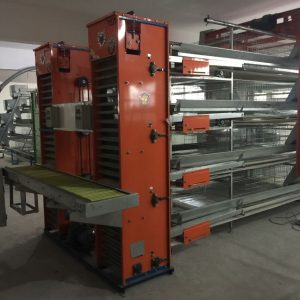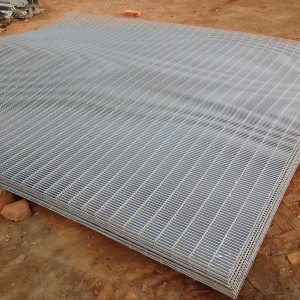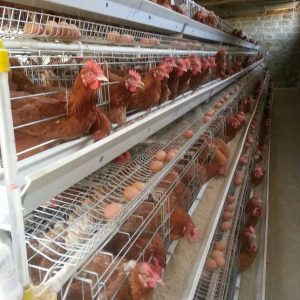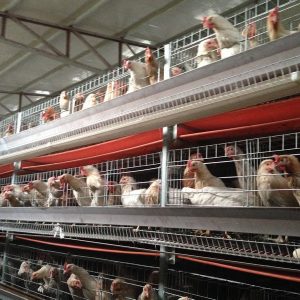
Three-dimensional cage broiler feeding management
The chicks are thoroughly cleaned and disinfected 5 days before entering the farm. Avoid using caustic soda and other corrosive disinfectants to prevent damage to the equipment. Then they are fumigated with formaldehyde and the doors and windows are sealed. After 24 hours, open the windows for ventilation. The personnel must be strictly disinfected to avoid destroying the disinfection effect. The feed trough and the drinking fountain are cleaned and disinfected. After the chicks arrive on the site, clean the ground every day to reduce the irritation of dust and chicken fluff on the respiratory tract. In the future, the whole chickens should be disinfected every other day. Several kinds of disinfectants can be used alternately, avoid the vaccination period for more than 24 hours during disinfection.
There is a temperature difference between the upper, middle and lower three-tier chicken cages in three-dimensional breeding, and the lower the outdoor temperature, the greater the temperature difference. Brooding chicks are generally at the highest level, because the highest level has the highest temperature, which helps to save heat. On the first day when the chicks enter the farm, the temperature should be controlled at 33~34℃. The temperature can also be adjusted according to the state of the chicks. When the temperature is right, the chickens are evenly distributed, lively, and have a strong appetite; when the temperature becomes low, they shrink their necks and bow their backs and concentrate on the heat source. Squeezing each other, the body trembles; when the temperature is too high, the amount of water drinking increases, the appetite decreases, the breathing speeds up, and the neck feathers are water-soaked. In the first week, the temperature drops to 30~C, and thereafter it drops by 2°C every week. The three-dimensional breeding density is high, which is 1~2~C lower than the flat rearing temperature. It should avoid causing heat stress and reducing the amount of food purchased.
Three-dimensional breeding broilers mostly use whole physical chicks. When the density of chicks is too high, group them in a timely manner to ensure that the chicks have a uniform weight. The first grouping is usually 12-16 days old. The grouping is too early. Because of its small size, it is easy to be in the gap of the breeding cage. Drilling out will also cause a waste of space, thereby wasting energy. For the second grouping, at the age of 25 to 28 days, the principle of “remaining weak and not strong” is adopted when grouping. The healthy young are placed in the lower level and the weak young are left behind. In summer, due to the high temperature, the cages can be separated appropriately. In winter, due to the large temperature difference between the upper and lower layers of the chicken cage, the time of cage separation can be delayed appropriately, and one more cage is placed in the lower cage to reduce the temperature difference between the upper and lower layers.
The key to successful breeding lies in ventilation. Reasonable ventilation can eliminate harmful gases, control temperature, and reduce the occurrence of ascites, chronic respiratory diseases and colibacillosis. The three-dimensional breeding unit has a large area of chicken house, so ventilation is more important. Within 24 hours after the chicks enter the farm, due to the large space for the whole sporting chicks, no ventilation is required. As the age of the chickens increases, gradually increase the amount of ventilation, adjust the position and size of the air inlet, day, night, cloudy, sunny, spring, summer, autumn and winter , It is necessary to keep adjusting in time to achieve the air in the house without peculiar smell, no glare, no hypoxia, and more comfortable feeling, creating a good growth space for the chickens, enhancing the body’s disease resistance and reducing the occurrence of diseases.
Large and medium-sized chicken farms have advanced equipment, but advanced equipment alone may not be able to raise chickens well. With the continuous improvement of scale and automation, breeding failures are not uncommon. The key lies in the organicity of people and equipment. In combination, the operator must not only be familiar with the principle of the equipment, but also observe frequently. Because there is a certain error between the temperature controller and the temperature value in the chicken house, the error value must be adjusted to the minimum so that the temperature of the chicken house can be adjusted to The most suitable temperature for the growth of chickens. In addition, the operator must be proficient in the use of equipment and the feeding procedures of the chickens at various stages, and be able to detect and repair equipment failures in time. Once equipment is used improperly or equipment fails, it will Cause huge economic losses.
After the chicks enter the house, ensure that they can drink water within 2 hours. For some weak ones, they can drink water manually by dipping their mouths. The purpose is to let the chicks learn to drink water as soon as possible. In addition, the height of the automatic drinking fountain should be moderate. If the dripper is too low, the chicks will stand in the dripper’s receiving cup and get wet. The dripper is too high and weak chicks cannot drink; in addition, adjust the water line appropriately. If the pressure of the pressure reducing valve is too high, the chicks are afraid that they will escape and waste water resources. If the pressure is too low, the water intake of the chicks at the end may not meet the standard. As the chicken age increases, increase the water pressure appropriately. For the first drinking of chicks, use warm water at 25°C, add 5% glucose and 0.1% vitamin c to the water, and rinse the drinking fountain frequently. During the brooding period, the drinking water should not be interrupted. From the second day of brooding, add 5% glucose and 0.1% vitamin c to the water. Drugs to prevent pullorum in chicks.
After the chicks are in the house, they must drink water first, and then feed them. This is conducive to the digestion of the chicks. 2 to 3 hours after drinking the water, put the feed in the opening tray for the chicks to peck. The three-dimensional breeding averages 25 chicks. The small trough must be fed less frequently to prevent feed contamination and mildew. It usually takes about seven days to open the trough, and then change to a long trough. The area of the long trough is large. At the end of the meal, the feed is less for the chicks. The speed starts to slow down, so use a brush frequently to sweep the feed to the side close to the chicken, which is good for the chicks to eat and prevent the feed from mildew. For the first 10 days, feed 6 to 8 times a day. In order to make the chicks have a good eating effect, it is best to feed them when they have eaten up immediately but have not eaten up. The chicks are fed regularly and quantitatively in strict accordance with the feeding standards for the first three days to prevent the broilers from growing too fast, resulting in incomplete development of the immune organs, so that the chickens have poor resistance to disease in the later stage. They can eat freely in the first three days.
The three-dimensional breeding chicken house uses artificial light to control the light time. Seven days before brooding, 24 hours of light is generally used, and then gradually dripped for 22 hours. The purpose is to let the chicks get used to the dark environment and prevent the chickens from panic and crowding due to sudden power failure Crushing casualties, and then gradually increased to 24 hours of light a week before the hurdle.



